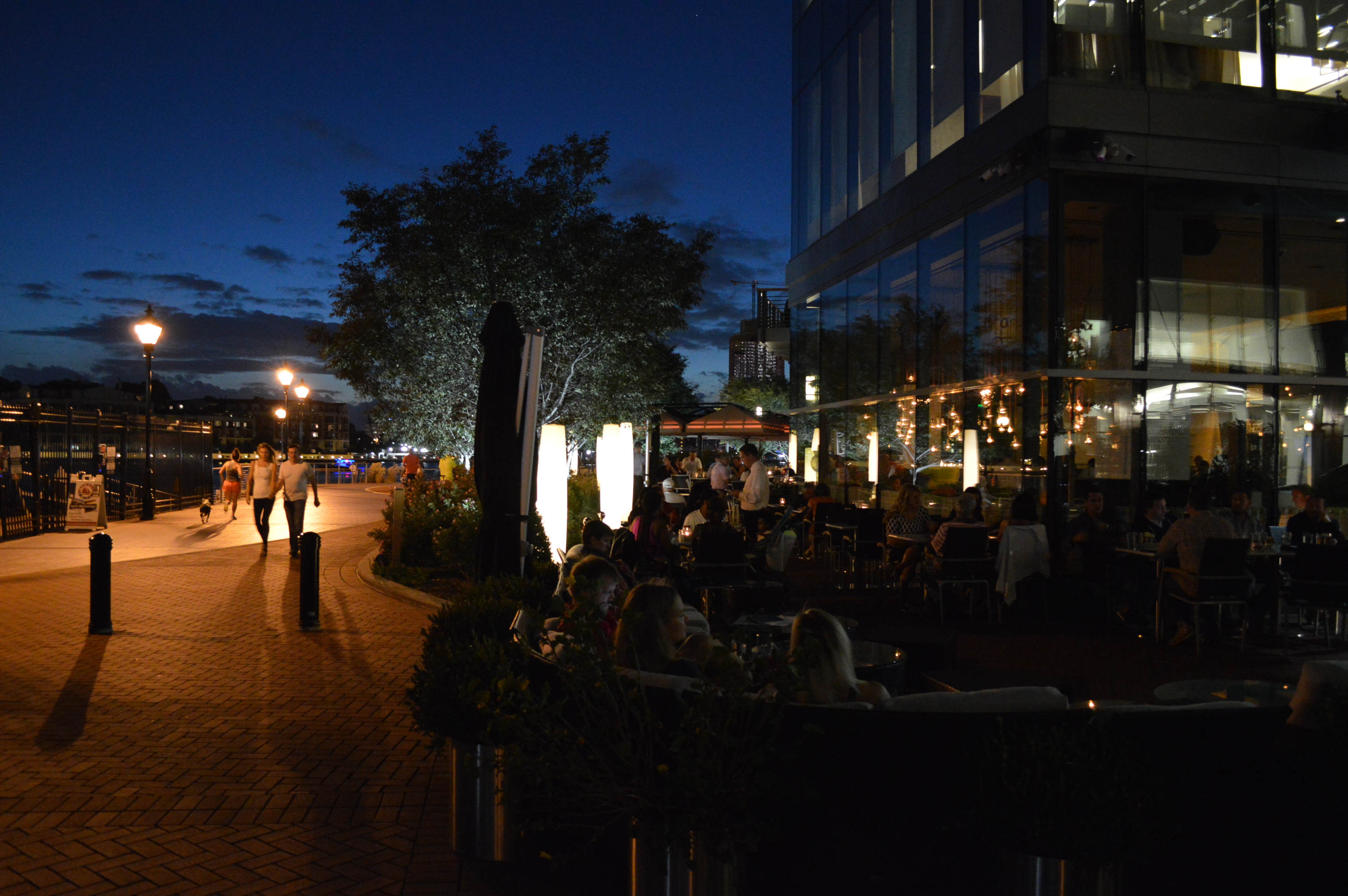Harbor East: Careful Planning Creates Urban Gem In Baltimore
Loch Bar diners make merry on a warm summer evening in Harbor East. (Anthony C. Hayes)
BALTIMORE, MD: In the early 1980s, the eastern part of Baltimore’s ‘basin’ consisted mostly of worn out warehouses, empty lots and rusting railroad tracks. Compared to the nearby and newly-launched Harbor Place, it was an archaic eyesore.
Most city residents never gave the section a second thought. But as a young carpentry contractor, this reporter often traversed the neighborhood en route to the antiquated Atlantic Mill & Lumber Company.
Atlantic Mill & Lumber was located at Dock & Willis Streets, adjacent to an iron foundry and an oil company. Trips across the deteriorated cobblestone streets could be a real challenge, but once inside the bow-beamed warehouses of the lumber yard, business carried on – even if the nearby iron and oil companies were a challenge to the olfactory receptors. All of that changed one April night in 1988, when a spectacular seven-alarm inferno reduced the aging complex to ashes. But even before that fateful fire, ambitious plans were afoot to completely revitalize the east side of the basin.
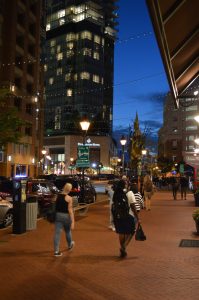
Thirty years later, the area now known as Harbor East is perhaps the brightest jewel in Baltimore’s civic crown.
Paired with the booming edifices of Harbor Point and the eclectic offerings of neighboring Fells Point, Harbor East is truly a shining example of visionary planning. But how did a group of novice developers – primarily financed by bread-baking magnate John Paterakis – turn a desolate locale into a glowing success story?
“I think the developers who planned it were pretty thoughtful in terms of how they laid it out,” said Baltimore City Councilman Zeke Cohen. “They were thoughtful and they didn’t settle. They went with what would be an optimal use of space. There is ground level retail with housing on top, so they created density to support the economic development. And there is a very good mix of restaurants at different price points. So, thought was put into matching the retail tenants with the neighborhood. It really just comes down to mindful planning.
“Being on the water is also helpful. It’s a beautiful area. To walk around the promenade and see the city across the water. I don’t know that there is any other magic formula to it. The Paterakis family owned the land and had significant influence on its use.”
Cohen also noted that the developers gave careful consideration to the business tenants. The James Joyce Irish Pub & Restaurant was one of Harbor East’s earliest entries.
“I’ve been here for 15 years,” said John Moore, General manager of the James Joyce Pub. “I employ forty-six people, and we are always busy. Harbor East is a fabulous place to be. It’s developed into an area where we have an incredible selection of hotels, so it’s a big attraction for conventions coming into the city.
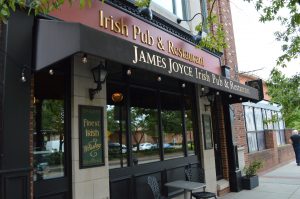
“A lot of those people come in for a meal, as do businessmen during the week. One of the good things that has happened with Harbor East is that, because of the selection of hotels and restaurants, the safety of the area, and the easy access to anyplace in the city, Harbor East has become a destination for out of town guests for weddings. Springtime, Summer, Fall we will have an average of 5-10 wedding parties in the area. So there are really a lot of good things going on here.”
Moore spoke glowingly about the Harbor East development, but he was also quick to credit Baltimore’s small business environment.
“This is a privately owned business. What makes us unique is that we are not part of a huge corporation. And we get anything we need from the city. Whether it’s the liquor licensing board or any of the other authorities. They are easy to approach and easy to work with. We have absolutely no problems. Baltimore has a lot going for it. It is a good place to do business.”
Harbor East is not only attractive to small businesses like the James Joyce Pub but to corporations like the Atlas Restaurant Group.
“Harbor East is unique because it has become Baltimore’s luxury district, featuring many high-end shops and restaurants in a small radius,” said Joe Sweeney – Director of Marketing for the Atlas Restaurant Group. “Because of the typical clientele that frequents the neighborhood, Harbor East continues to push the boundaries of what Baltimore has historically been accustomed to. The fine-dining restaurants are some of the best in the city with impressive accolades from all the local media. The restaurant scene features cuisines from all around the world, including Japanese at Azumi, Mediterranean at Ouzo Bay, and local Maryland fare at Loch Bar.
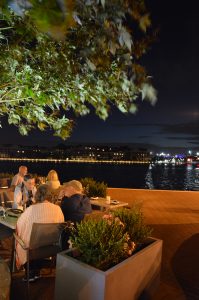
Sweeney said that, as a restaurant group, Harbor East has become the most attractive neighborhood in the city.
“There is a sophisticated demographic that frequents the shops and restaurants. Harbor East has become a dining destination for people in the city and from the county. With close access to I-83, Harbor East is a quick and easy drive for guests who live in the counties surrounding the city. Having many hotels in the neighborhood also helps to drive traffic to our restaurants. Tourists are always interested in dining at the local spots.
“I also think Harbor East has done a great job at making this neighborhood feel like a community by hosting many events all year that help push your individual businesses. The Harbor East marketing department does a great job at promoting your business through social media and larger advertising campaigns.”
What has the Atlas Restaurant Group learned from its experience in Harbor East?
“We have learned that our guests demand perfection when they dine at our locations. That has helped motivate and push our management and staff at each location. We have learned how to handle the summer influx of tourists who are looking to dine at our restaurants and to stay updated on the city’s convention schedule.”
Speaking with other vendors, such as the counter help at Charm City Cakes on South President Street, the themes raised by Cohen, Moore and Sweeney seemed to recur time and time again. And not surprisingly, the patronage generated by Harbor East’s hotels, apartments, restaurants and attractions, has created a boom to individuals and small businesses in neighboring areas.

“Well, Harbor East must doing something positive, because over the last 2-3 months, I’ve been doing better than I’ve ever done in my life,” said Fells Point artist Loring Cornish.
Cornish’s Thames Street studio is just a cobblestone’s throw from Harbor East. From his door, he has witnessed new buildings rise in Harbor Point, on the former acreage of Atlantic Mill & Lumber. And with his bike, he leisurely pedals the promenade of Harbor East – enjoying the sun and the friendly waves of dockside diners.
“Isn’t it amazing down here?” he asked, while gazing at the pleasing panorama of the Inner Harbor. “And even with all the construction that is going on, it’s not bad. I’m loving it!
“My mortgage is already paid up through 2018. This has been a great influx for me financially. An artist owning his own building and surviving in a high tax area is a great accomplishment. So I applaud those who had the vision to build this area. Even though it is inconvenient from time-to-time, the overall effect is great for the community.”
Traffic detours and construction cranes may be an inconvenience. Yet they offer a fleeting glimpse of Harbor East’s industrial past. And while the expansive warehouses, lumber mills, iron works and oil depot may be gone, the most important element has reemerged: People – working, living and thriving in an area once battered and sadly forlorn. Credit the politicians and community activists who put forth the initial idea, and the businessmen with the vision and courage to make it all happen.
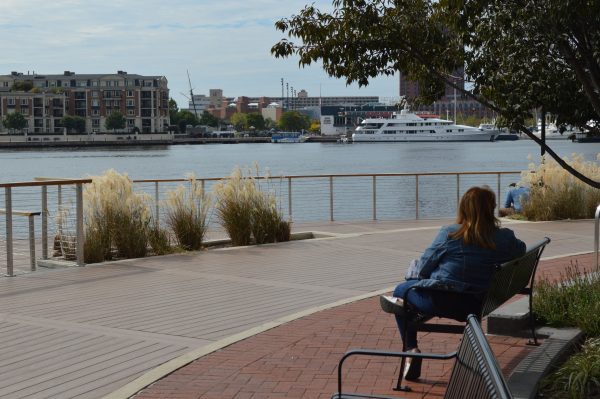

Anthony C. Hayes is an actor, author, raconteur, rapscallion and bon vivant. A one-time newsboy for the Evening Sun and professional presence at the Washington Herald, Tony’s poetry, photography, humor, and prose have also been featured in Smile, Hon, You’re in Baltimore!, Destination Maryland, Magic Octopus Magazine, Los Angeles Post-Examiner, Voice of Baltimore, SmartCEO, Alvarez Fiction, and Tales of Blood and Roses. If you notice that his work has been purloined, please let him know. As the Good Book says, “Thou shalt not steal.”

